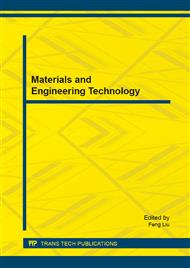[1]
B.Y. Mokritskii, A.V. Kirichek, A.M. Shpilev, D.A. Pustovalov, P.A. Sablin, Acoustic assessment of tool quality, (2013) Russian Engineering Research, 33 (2), pp.74-78.
DOI: 10.3103/s1068798x13020111
Google Scholar
[2]
B. Ya. Mokritskii, Tool Materials for Chemical Machine Building, (2014) Chemical and Petroleum Engineering, 49 (9-10), pp.639-640.
DOI: 10.1007/s10556-014-9810-4
Google Scholar
[3]
B.Y. Mokritskii, Method of assessing the properties of tool materials and cutting tool performance diagnostics, «Plant Laboratory. Diagnostics of Materials» No 9, 2010, Vol 76 pp.41-43 (in Russian).
Google Scholar
[4]
D.A. Pustovalov, B.Y. Mokritskii, V.V. Petrov and other, R.F. Patent 2495412, MPK G01N 29/00 , Method of comparative evaluation of the properties of materials (in Russian).
Google Scholar
[5]
Films and Coatings 2001: Proceeding of the 6-th International «A Film and Coatings» 2001/ Under edition of the V.S. Klubnikin. SPb: Publisher SPbSTU, 2001. 658p. (in Russian).
Google Scholar
[6]
D.A. Pustovalov, B.Y. Mokritskii, S.A. Ogilko, I.V. Lavrukhin, K.O. Belyanin, Pendulum sclerometer for evaluating material corrosion resistance, (2013) Chemical and Petroleum Engineering, 48 (11-12), pp.688-692.
DOI: 10.1007/s10556-013-9681-0
Google Scholar
[7]
D.A. Pustovalov, B.Y. Mokritskii, V.V. Petrov, S.A. Ogilko and other, R.F. Patent 2495412, The method of comparative evaluation of the properties of materials (in Russian).
Google Scholar
[8]
A.V. Verkhoturov, E.G. Babenko, V.M. Makienko, Methodology for the creation of welding consumables, edited by B.A. Voronov, Khabarovsk, DVGUPS, 2009. 128 p.
Google Scholar
[9]
A. A. Vereshchaka, A. S. Vereshchaka, O. Mgaloblishvili, M. N. Morgan, A. D. Batako, Nano-scale multilayered-composite coatings for the cutting tools, International Journal of Advanced Manufacturing Technology, 2014. V. 72, Is. 1-4. pp.303-317.
DOI: 10.1007/s00170-014-5673-2
Google Scholar
[10]
A. A. Vereschaka, M. A. Volosova, S. N. Grigoriev, A. S. Vereschaka, Development of wear-resistant complex for high-speed steel tool when using process of combined cathodic vacuum arc deposition, Procedia CIRP 9, (2013), Elsevier B.V. pp.8-12.
DOI: 10.1016/j.procir.2013.06.159
Google Scholar
[11]
Vereschaka Alexey, Development of assisted filteredcathodicvacuum arcdepositionof nano-dispersed multi-layeredcomposite coatingsoncutting tools, Key Engineering Materials Vol. 581 (2014) pp.62-67.
DOI: 10.4028/www.scientific.net/kem.581.62
Google Scholar
[12]
A.S. Vereschaka, S.N. Grigoriev, E.S. Sotova, A.A. Vereschaka, Improving the efficiency of the cutting tools made of mixed ceramics by applying modifying nano-scale multilayered coatingsAdvanced Materials Research, 2013. V. 712-715. pp.391-394.
DOI: 10.4028/www.scientific.net/amr.712-715.391
Google Scholar
[13]
A.S. Vereschaka, S.N. Grigoriev, V.P. Tabakov, E.S. Sotova, A.A. Vereschaka, M. Yu. Kulikov, Improving the efficiency of the cutting tool made of ceramic when machining hardened steel by applying nano-dispersed multi-layered coatings, Key Engineering Materials, 2014. V. 581. pp.68-73.
DOI: 10.4028/www.scientific.net/kem.581.68
Google Scholar
[14]
A. A. Vereschaka, A. S. Vereschaka, S. N. Grigoriev, D.V. Sladkov, Nano-Scale Multi-Layered Coatings for Cutting Tools Generated Using Assisted Filtered Cathodic-Vacuum-Arc Deposition (AFCVAD), Applied Mechanics and Materials, Vols. 325-326 (2013).
DOI: 10.4028/www.scientific.net/amm.325-326.1454
Google Scholar
[15]
A.A. Vereschaka, A.S. Vereschaka, A.I. Anikeev, Carbide Tools with Nano-Dispersed Coating for High-Performance Cutting of Hard-To-Cut Materials, Advanced Materials Research, 2014. V. 871. pp.164-170.
DOI: 10.4028/www.scientific.net/amr.871.164
Google Scholar


